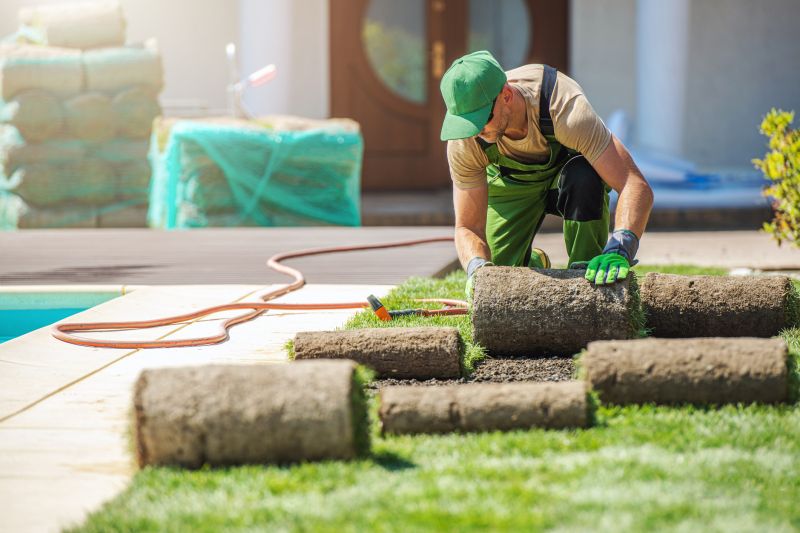Leading Products For Effective Swale Construction Projects
Choose from top-rated products that help you build functional swales with proper water flow control and stability.
 Swale installations are an effective landscape feature used to manage water runoff and promote proper drainage on properties with uneven terrain. They consist of shallow, vegetated channels designed to direct excess water away from foundations, walkways, and other structures, reducing erosion and pooling. Proper selection of products for swale installation ensures that the system functions efficiently and remains durable over time. From flexible liners to sturdy edging materials, the right components can help create a sustainable and low-maintenance drainage solution.
Swale installations are an effective landscape feature used to manage water runoff and promote proper drainage on properties with uneven terrain. They consist of shallow, vegetated channels designed to direct excess water away from foundations, walkways, and other structures, reducing erosion and pooling. Proper selection of products for swale installation ensures that the system functions efficiently and remains durable over time. From flexible liners to sturdy edging materials, the right components can help create a sustainable and low-maintenance drainage solution.
Types of Products For Swale Installations
Erosion Control Blankets
Protects soil from erosion and promotes vegetation growth within the swale.
Landscape Edging Materials
Defines the swale boundaries and prevents soil migration, available in various materials like plastic, metal, or rubber.
Drainage Pipe Systems
Allows efficient water flow through the swale, often made of perforated or solid plastic pipes.
Geotextile Fabrics
Provides filtration to prevent soil from clogging drainage systems while allowing water passage.
Flexible Drainage Liners
Conforms to irregular shapes, creating a barrier that maintains the swale’s shape and prevents soil erosion.
Gravel and Rock Aggregates
Used as a base layer or for surface coverage to facilitate water flow and reinforce the swale bed.
Vegetation Planting Kits
Includes native grasses and plants that help stabilize the soil and improve water absorption.
Erosion Control Meshes
Supports vegetation growth and holds soil in place on slopes and channel sides.
Inlet and Outlet Structures
Facilitates controlled water entry and exit points within the swale system.
Water Flow Regulators
Controls the rate of water movement through the swale, preventing overflow and erosion.
Erosion Control Pillows
Provides immediate stabilization on slopes and vulnerable areas of the swale.
Plastic or Metal Stakes
Secures edging and other components in place for long-term stability.
Mulch and Soil Amendments
Supports vegetation establishment and soil health within the swale area.
Perforated Drain Tiles
Enhances drainage capacity in larger swale systems or areas with high water volume.
Filter Socks
Helps trap debris and prevent clogging at inlet and outlet points.
Popular Choices
Widely used for shaping and lining swale channels due to their adaptability and durability.
Commonly selected for their ability to facilitate even water distribution within the swale.
Popular for stabilizing slopes and promoting vegetation growth in swale areas.
Chosen for defining borders and maintaining the shape of the swale over time.
Preferred for establishing resilient vegetation that supports water management.
Frequently used for filtration and separation within drainage systems.
Commonly incorporated for surface coverage and base layers to enhance drainage.
Popular for controlling water entry and exit points effectively.
Often selected to regulate water flow and prevent overflow issues.
Used frequently for slope stabilization and vegetation support.
Commonly applied to improve soil health and plant establishment.
Popular for securing edging and other components firmly in place.
Constructing a swale involves careful planning and the integration of various products that work together to channel water effectively. Depending on the specific site conditions, different materials may be needed to reinforce the channel, prevent erosion, and facilitate water flow. It is essential to consider the slope, soil type, and anticipated water volume when choosing products to ensure the swale performs as intended. Additionally, incorporating appropriate vegetation and erosion control measures can enhance the stability and longevity of the installation.
Selecting the appropriate products for a swale project involves balancing durability, ease of installation, and compatibility with existing landscape features. Many options are available to customize the design, from flexible liners that conform to irregular shapes to robust edging systems that maintain the swale's structure. Properly installed, these products can help mitigate water-related issues and contribute to a well-functioning landscape drainage system. Consulting with landscape professionals or drainage specialists can provide further insights into the best product choices for specific site needs.
Key Buying Considerations
- Assess the slope and terrain to determine the appropriate size and shape of the swale.
- Choose materials that are compatible with the soil type and expected water volume.
- Consider durability and resistance to weathering for long-term performance.
- Select erosion control products that support vegetation establishment and soil stability.
- Evaluate ease of installation and maintenance requirements for each product.
- Ensure that drainage pipes and outlets are appropriately sized for the anticipated flow.
- Incorporate filtration fabrics to prevent clogging and soil migration within the system.
- Opt for flexible liners that can conform to irregular shapes if the design demands it.
- Use sturdy edging to maintain the swale's shape and prevent soil migration over time.
- Plan for access points such as inlets and outlets to facilitate water management.
- Consider the aesthetic integration of the swale with the surrounding landscape.
- Account for future growth of vegetation and potential root intrusion that could affect components.
- Check for compatibility of all products to ensure seamless installation.
- Review product warranties and manufacturer support for long-term assurance.
- Prioritize products that support effective water flow and prevent pooling or erosion.
